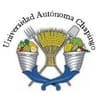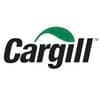Comportamiento de bovinos en pastoreo
Comportamiento de ingestión y consumo de forraje por vacas en pastoreo en clima templado. Revisión
El objetivo fue revisar, con base en publicaciones predominantemente recientes, el conocimiento sobre los componentes del comportamiento de ingestión (CI) de vacas que pastorean en clima templado, y su relación con las características de las praderas que regulan el consumo diario de forraje (CF). Los componentes del CI que median el CF son masa de bocado (MB, g MS bocado-1), tasa de bocados (TB, bocados min-1), tasa de consumo (TC, g MS min-1) y tiempo de pastoreo (TP, min día-1). La masa, altura y densidad del forraje de las praderas afectan la MB y consecuentemente, el CF. La altura de la pradera se relaciona con los componentes del CI y es útil para evaluar el CF. Con base en estudios en praderas templadas en estado vegetativo, se destaca que el CF de vacas aumenta con incrementos en altura de la pradera, porque cosechan bocados de mayor MB, lo que les permite obtener altas TC. Pero, hay evidencia de que la TC puede disminuir en praderas demasiado altas; para procesar bocados más grandes, las vacas reducen su TB y ejecutan mayor cantidad de movimientos mandibulares compuestos y de masticación. Por el contrario, en praderas cortas las vacas aumentan su TB y TP, para remediar la reducción en la TC debida a la cosecha de bocados de menor peso, aunque esto no compensa completamente la disminución de TC. Por lo anterior, para mantener altas TC las vacas no deben ser forzadas a consumir forraje a altas intensidades de pastoreo.
Palabras clave: Tasa de consumo, Tiempo de pastoreo, Tasa de bocados, Masa de bocado, Altura de pradera.
Introducción
Comportamiento de ingestión y escalas de pastoreo
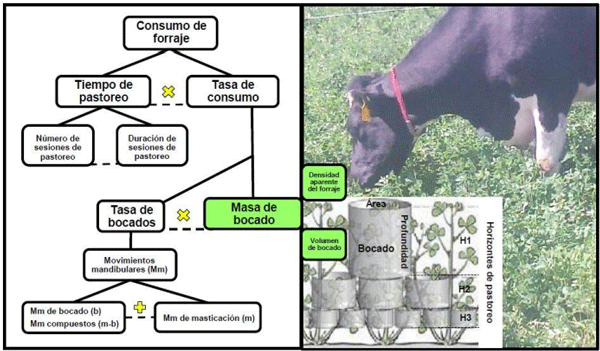
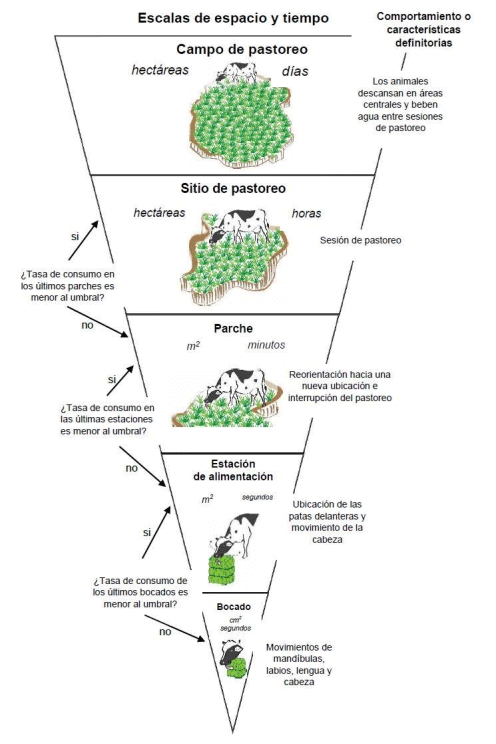
Dimensiones del bocado
La altura de la pradera en el consumo
La reducción de la altura de la pradera en el consumo
El tiempo de pastoreo y el consumo de forraje
Tasa de consumo de diferentes categorías
Conclusiones
Agradecimientos y conflicto de interés
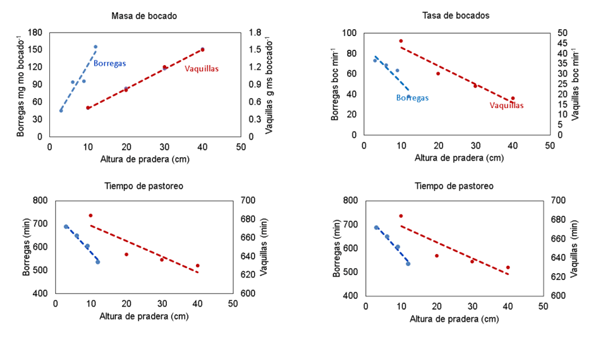
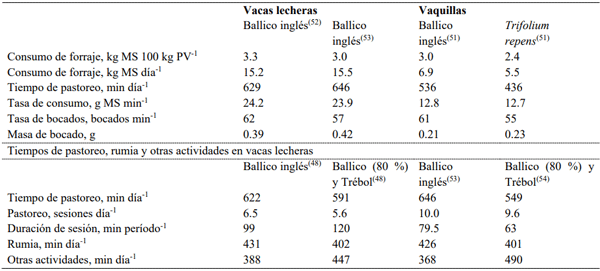
1. Carvalho PCF. Harry Stobbs Memorial Lecture: Can grazing behavior support innovations in grassland management? Trop Grassl 2013;1(2):137-155. https://doi.org/10.17138/tgft(1)137-155.
2. Gregorini P. Diurnal grazing pattern: its physiological basis and strategic management. Anim Prod Sci 2012;52:416-430. http://dx.doi.org/10.1071/AN11250.
3. Villalba JJ, Provenza FD, Catanese F, Distel RA. Understanding and manipulating diet choice in grazing animals. Anim Prod Sci 2015;55:261-271. http://dx.doi.org/10.1071/AN14449.
4. Sheahan AJ, Kolver ES, Roche JR. Genetic strain and diet effects on grazing behavior, pasture intake, and milk production. J Dairy Sci 2011;94(7):3583-3591. http://dx.doi.org/10.3168/jds.2010-4089.
5. Carvalho PCF, Bremm C, Mezzalira JC, Fonseca L, Trindade JK, Bonnet OJF, et al. Can animal performance be predicted from short-term grazing processes? Anim Prod Sci 2015;55:319-327. https://doi.org/10.1071/AN14546.
6. Boval M, Sauvant, D. Ingestive behaviour of grazing ruminants: Meta-analysis of the components linking bite mass to daily intake. Anim Feed Sci Technol 2021;278 115014. https://doi.org/10.1016/j.anifeedsci.2021.115014.
7. Chilibroste P, Gibb MJ, Soca P, Mattiauda DA. Behavioural adaptation of grazing dairy cows to changes in feeding management: do they follow a predictable pattern? Anim Prod Sci 2015;55:328-338. https://doi.org/10.1071/AN14484.
8. Yayota M, Doi K, Kawamura K, Ogura S. Monitoring foraging behavior in ruminants in a diverse pasture. J Integr Field Sci 2017;14:39-47.
9. Bailey DW, Provenza FD. Mechanisms determining large-herbivore distribution. In: Prins HHT, Langevelde F, editors. Resource ecology: Spatial and temporal dynamics of foraging. Dordrecht, The Netherlands: Springer; 2008:7-28.
10. Boval M, Sauvant D. Ingestive behaviour of grazing ruminants: meta-analysis of the components of bite mass. Anim Feed Sci Technol 2019;251:96-111. https://doi.org/10.1016/j.anifeedsci.2019.03.002.
11. Benvenutti MA, Cangiano CA. Características de las pasturas y su relación con el comportamiento ingestivo y consumo en pastoreo. En: Cangiano CA, Brizuela MA, editores. Producción Animal en Pastoreo. Buenos Aires, Argentina: Instituto Nacional de Tecnología Agropecuaria; 2011:259-290.
12. Andriamandroso AHL, Bindelle J, Mercatoris B, Lebeau F. A review on the use of sensors to monitor cattle jaw movements and behavior when grazing. Biotechnol Agron Soc Environ 2016;20:1-14. https://doi.org/10.25518/1780-4507.13058.
13. Carvalho PCF, Trindade JK, Bremm C, Mezzalira JC, Fonseca L. Comportamiento ingestivo de animais em pastejo. In: Reis RA, Bernardes TF, Siqueira GR, editores. Forragicultura: Ciência, Tecnologia y Gestão dos Recursos Forrageiros. Jaboticabal, SP, Brasil: Gráfica Multipress; 2013:525-545.
14. Gonçalves EN, Carvalho PCF, Devincenzi T, Lopes MLT, Freitas FK, Jacques AVA.
15. Relações planta-animal em ambiente pastoril heterogêneo: padrões de deslocamento e uso de estações alimentares. Rev Bras Zootec 2009;38(11):2121-2126. https://doi.org/10.1590/S1516-35982009001100008.
16. Bailey DW, Stephenson MB, Pittarello M. Effect of terrain heterogeneity on feeding site selection and livestock movement patterns. Anim Prod Sci 2015;55:298-308. http://dx.doi.org/10.1071/AN14462.
17. Larson-Praplan S, George MR, Buckhouse JC, Laca EA. Spatial and temporal domains of scale of grazing cattle. Anim Prod Sci 2015;55:284-297. https://doi.org/10.1071/AN14641.
17. Brizuela MA, Cibils A. Implicancias de la carga animal, distribución de los animales y métodos de pastoreo en la utilización de praderas. En: Cangiano CA, Brizuela MA, editores. Producción Animal en Pastoreo. Buenos Aires, Argentina: Instituto Nacional de Tecnología Agropecuaria; 2011:349-376.
18. Dolev A, Henkin Z, Brosh A, Yehuda Y, Ungar ED, Shabtay A, et al. Foraging behavior of two cattle breeds, a whole-year study: II. Spatial distribution by breed and season. J Anim Sci 2014;92:758-766. https://doi.org/10.2527/jas2013-6996.
19. Hirata M, Matsubara A, Uchimura M. Effects of group composition on social foraging in cattle: inclusion of a leader cow in replacement of a follower facilitates expansion of grazing distribution patterns of beef cows. J Ethol 2022;40:71-78. https://doi.org/10.1007/s10164-021-00731-0.
20. Doyle PR, McGee M, Moloney AP, Kelly AK, O’Riordan EG. Effect of post-grazing sward height, sire genotype and indoor finishing diet on steer intake, growth and production in grass-based suckler weanling-to-beef systems. Animals 2021;11:2623. https://doi.org/10.3390/ani11092623.
21. Do Carmo M, Genro TCM, Cibils AF, Soca PM. Herbage mass and allowance and animal genotype affect daily herbage intake, productivity, and efficiency of beef cows grazing native subtropical grassland. J Anim Sci 2021;99(10):skab279. https://doi.org/10.1093/jas/skab279.
22. Cangiano CA, Galli JR, Pece MA, Dichio L, Rozsypalek SH. Effect of liveweight and pasture height on cattle bite dimensions during progressive defoliation. Aust J Agric Res 2002;53:541-549. https://doi.org/10.1071/AR99105.
23. Galli JR, Cangiano CA, Pece MA, Larripa MJ. Monitoring and assessment of ingestive chewing sounds for prediction of herbage intake rate in grazing cattle. Animal 2018;12:973-982. https://doi.org/10.1017/S1751731117002415.
24. Mezzalira JC, Carvalho PCF, Fonseca L, Bremm C, Cangiano C, Gonda HL, et al. Behavioural mechanisms of intake rate by heifers grazing swards of contrasting structures. Appl Anim Behav Sci 2014;153:1-9. https://doi.org/10.1016/j.applanim.2013.12.014.
25. Menegazzi G, Giles PY, Oborsky M, Fast O, Mattiauda DA, Genro TCM, et al. Effect of post-grazing sward height on ingestive behavior, dry matter intake, and milk production of Holstein dairy cows. Front Anim Sci 2021;2:742685. https://doi.org/10.3389/fanim.2021.742685.
26. Griffiths WM, Hodgson J, Arnold GC. The influence of sward canopy structure on foraging decisions by grazing cattle II. Regulation of bite depth. Grass Forage Sci 2003;58:125-137. https://doi.org/10.1046/j.1365-2494.2003.00360.x.
27. Utsumi SA, Cangiano CA, Galli JR, McEachern MB, Demment MW, Laca EA. Resource heterogeneity and foraging behaviour of cattle across spatial scales. BMC Ecol 2009;9:1-10. https://doi.org/10.1186/1472-6785-9-9.
28. Pulina G, Dias FAH, Stefanon B, Sevi A, Calamari L, Lacetera N, et al. Sustainable ruminant production to help feed the planet. Ital J Anim Sci 2017;16(1):140-171. http://dx.doi.org/10.1080/1828051X.2016.1260500.
29. Da Silva SC, Gimenes FMA, Sarmento DOL, Sbrissia AF, Oliveira DE, HernándezGaray, et al. Grazing behaviour, herbage intake and animal performance of beef cattle heifers on Marandu palisade grass subjected to intensities of continuous stocking management. J Agric Sci 2013;151:727-739. https://doi.org/10.1017/S0021859612000858.
30. Rombach M, Münger A, Niederhauser J, Südekum K-H, Schori F. Evaluation and validation of an automatic jaw movement recorder (RumiWatch) for ingestive and rumination behaviors of dairy cows during grazing and supplementation. J Dairy Sci 2018;101:2463-2475. https://doi.org/10.3168/jds.2016-12305.
31. Vanrell, SR, Chelotti, JO, Bugnona, LA Rufiner, HL Milone, DH, Laca, EA, Galli, JR. Audio recordings dataset of grazing jaw movements in dairy cattle. Data Brief 2020, 30:105623. https://doi.org/10.1016/j.dib.2020.105623.
32. Galli JR, Milone DH, Cangiano CA, Martínez CE, Laca EA, Chelotti JO, et al. Discriminative power of acoustic features for jaw movement classification in cattle and sheep. Bioacoustics 2020;29(5):602-616. https://doi.org/10.1080/09524622.2019.1633959.
33. Laca EA. Modelling spatial aspects of plant–animal interactions. In: Lemaire G, et al editors. Grassland ecophysiology and grazing ecology. Wallingford, UK: CAB International; 2000:209-231.
34. Baggio C, Carvalho PCF, Da Silva JLS, Anghinoni I, Lopes MLT, Thurow JM. Padrões de deslocamento e captura de forragem por novilhos em pastagem de azevém-anual e aveia-preta manejada sob diferentes alturas em sistema de integração lavoura-pecuária. Rev Bras Zootec 2009;38(2):215-222. https://doi.org/10.1590/S1516- 35982009000200001.
35. Gregorini P, Gunter AS, Beck PA, Caldwell J, Bowman MT, Coblentz WK. Short-term foraging dynamics of cattle grazing swards with different canopy structures. J Anim Sci 2009; 87:3817-3824. https://doi.org/10.2527/jas.2009-2094.
36. Searle KR, Shipley LA. The comparative feeding behaviour of large browsing and grazing herbivores. In: Gordon IJ, Prins HHT editors. The ecology of browsing and grazing. Heidelberg, Germany: Springer 2008;117-148.
37. Benvenutti MA, Poppi DP, Crowther R, Spinks W, Moreno FC. The horizontal barrier effect of stems on the foraging behaviour of cattle grazing five tropical grasses. Livest Sci 2009;126:229–238. https://doi.org/10.1016/j.livsci.2009.07.006.
38. Fonseca L, Carvalho PCF, Mezzalira JC, Bremm C, Galli JR, Gregorini P. Effect of sward surface height and level of herbage depletion on bite features of cattle grazing Sorghum bicolor swards. J Anim Sci 2013;91:4357-4365. https://doi.org/10.2527/jas.2012-5602.
39. Brink GE, Soder KJ. Relationship between herbage intake and sward structure of grazed temperate grasses. Crop Sci 2011;51:2289-2298. https://doi.org/10.2135/cropsci201().10.0600.
40. Penning PD, Rook AJ, Orr RJ. Patterns of ingestive behaviour of sheep continuously stocked on monocultures of ryegrass or white clover. Appl Anim Behav Sci 1991;31:237-250. https://doi.org/10.1016/0168-1591(91)90008-L.
41. Gonçalves EN, Carvalho PCF, Kunrath TR, Carassai IJ, Bremm C, Fischer V. Relações planta-animal em ambiente pastoril heterogêneo: processo de ingestão de forragem. Rev Bras Zootec 2009;38(9):1655-1662.
42. Silva GP, Fialho CA, Carvalho LR, Fonseca L, Carvalho PCF, Bremm C, et al. Sward structure and short-term herbage intake in Arachis pintoi cv. Belmonte subjected to varying intensities of grazing. J Agric Sci 2017;156:92-99. https://doi.org/10.1017/S0021859617000855.
43. Mezzalira JC, Bonnet OJF, Carvalho PCF, Fonseca L, Bremm C, Mezzalira CC, et al. Mechanisms and implications of a type IV functional response for short-term intake rate of dry matter in large mammalian herbivores. J Anim Ecol 2017;86:1159-1168. https://doi.org/ 10.1111/1365-2656.12698.
44. Piña LF, Balocchi OA, Keim JP, Pulido RG, Rosas F. Pre-grazing herbage mass affects grazing behavior, herbage disappearance, and the residual nutritive value of a pasture during the first grazing session. Animals 2020;10(2):212 doi:10.3390/ani10020212.
45. Savian JV, Schons RMT, Mezzalira JC, Neto AB, da Silva Neto GF, Benvenutti MA, et al. A comparison of two rotational stocking strategies on the foraging behaviour and herbage intake by grazing sheep. Animal 2020;14(12):2503-2510. https://doi.org/ 10.1017/S1751731120001251.
46. Fonseca L, Mezzalira JC, Bremm C, Filho RSA, Gonda HL, Carvalho PCF. Management targets for maximizing the short-term herbage intake rate of cattle grazing in Sorghum bicolor. Livest Sci 2012;145:205-211. https://doi.org/10.1016/j.livsci.2012.02.003.
47. Castro ME, Andriamandroso ALH, Beckers Y, Rond L, Montufar C, Da Silva NGF, et al. Analysis of the nutritional and productive behaviour of dairy cows under three rotation bands of pastures, Pichincha, Ecuador. J Agric Rural Dev Trop Subtrop 2021;122(2): 289-298. https://doi.org/10.17170/kobra-202112035148.
48. Henriquez-Hidalgo D, Hennessy D, Gilliland T, Egan M, Mee JF, Lewis E. Effect of rotationally grazing perennial ryegrass white clover or perennial ryegrass only swards on dairy cow feeding behaviour, rumen characteristics and sward depletion patterns. Livest Sci 2014;169:48-62. https://doi.org/10.1016/j.livsci.2014.09.002.
49. Sheahan AJ, Boston RC, Roche JR. Diurnal patterns of grazing behavior and humoral factors in supplemented dairy cows. J Dairy Sci 2013;96:3201-3210. https://doi.org/10.3168/jds.2012-6201 10.3168/jds.2012-6201.
50. Baggio C, Carvalho PCF, Da Silva JLS, Rocha LM, Bremm C, Santos DT, et al. Padrões de uso do tempo por novilhos em pastagem consorciada de azevém anual e aveia-preta. Rev Bras Zootec 2008;37(11):1912-1928. https://doi.org/10.1590/S1516- 35982008001100002.
51. Rutter SM, Orr RJ, Penning PD, Yarrow NH, Champion RA. Ingestive behaviour of heifers grazing monocultures of ryegrass or white clover. Appl Anim Behav Sci 2002;76:1-9. https://doi.org/10.1016/S0168-1591(01)00205-2.
52. Ganche E, Delaby L, O’Donovan M, Boland TM, Kennedy E. Short-term response in milk production, dry matter intake, and grazing behavior of dairy cows to changes in postgrazing sward height. J Dairy Sci 2014;97:3028-3041. https://doi.org/10.3168/jds.2013-7475.
53. Prendiville R, Lewis E, Pierce KM, Buckley F. Comparative grazing behavior of lactating Holstein-Friesian, Jersey, and Jersey × Holstein-Friesian dairy cows and its association with intake capacity and production efficiency. J Dairy Sci 2010;93:764-774. https://doi.org/10.3168/jds.2009-2659.
54. Kennedy E, McEvoy M, Murphy JP, O’Donovan M. Effect of restricted access time to pasture on dairy cow milk production, grazing behaviour, and dry matter intake. J Dairy Sci 2009;92:168-176. https://doi.org/10.3168/jds.2008-1091.
